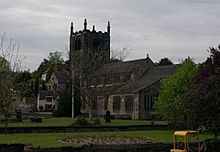Church of All Saints, Bingley facts for kids
Quick facts for kids Church of All Saints, Bingley |
|
|---|---|

Church of All Saints, Bingley
|
|
| Country | England |
| Denomination | Church of England |
| Churchmanship | Central |
| Weekly attendance | 250 |
| History | |
| Status | Parish Church |
| Architecture | |
| Functional status | Active |
| Heritage designation | Grade II |
| Designated | 9 August 1966 |
| Administration | |
| Parish | All Saints Bingley |
| Deanery | Airedale |
| Archdeaconry | Bradford |
| Diocese | Leeds |
The Church of All Saints is an important Anglican church in Bingley, West Yorkshire, England. It's one of two Anglican churches in the town. This church has been around since Norman times, which means it's very old! You can find it in the oldest part of Bingley, close to the River Aire and Ireland Bridge.
Contents
A Long History
The Church of All Saints has a very long history. It might even have started before the Normans came to England in 1066! People think there could have been a wooden church here for many years. But there are no written records from that time.
The first records show that the church was rebuilt after 1066. This was done by William Paganel, who was the Lord of the Manor (a very important person in the area). He gave the church to Drax Priory around the time of Archbishop Thurstan (1119–1140).
Building Through the Years
The church building you see today was started during the time of King Henry VIII (1491–1547). The part of the church where the choir sings, called the choir, was built in 1518. This is when the church was named All Saints. Before that, it was called Saint Lawrence.
The tall tower of the church was built in the 15th century. It was made even taller in 1739 with a new belfry (where the bells are kept). The two-light bell openings on each side of the tower were added later, in the 1800s.
Changes and Additions
In 1856, the church got a new clock. Then, in 1870–1871, the church was updated. Some old wooden seats that belonged to local important families were removed.
The church has a beautiful stained-glass window. It was made by famous artists William Morris and Edward Burne-Jones. The church also has a set of bells. For many years, there were six bells. Two more were added in 1873.
In 1904, a new road was built next to the church. This road cut the churchyard in two! Some old gravestones were used to make paths. One gravestone that was lost belonged to John Nicholson, a poet buried there in 1843.
Important Status
The Church of All Saints is a very important historical building. In 1966, it was given a special status called Grade II*. This means it's a building of more than special interest. The two gate piers (tall posts) at the south of the church were also listed as Grade II in 1985.
The church is in the oldest part of Bingley. There used to be a school and maybe even a castle nearby! The Old White Horse Inn and Ireland Bridge are also close by. The Old Main Street still has its old cobbled stones.
Church Community
The Church of All Saints is part of a larger group of churches. This group includes St. Aidan in Crossflatts and St. Lawrence in Eldwick. It's also part of the Bingley Group Ministry, which includes Holy Trinity Church and St Wilfreds in Gilstead.
The church used to be in the Diocese of Bradford. But since April 20, 2014, it is now part of the Diocese of Leeds.
In October 2018, a special service was held with the Bishop of Leeds, Nick Baines. This service celebrated 500 years of worship at the church!

